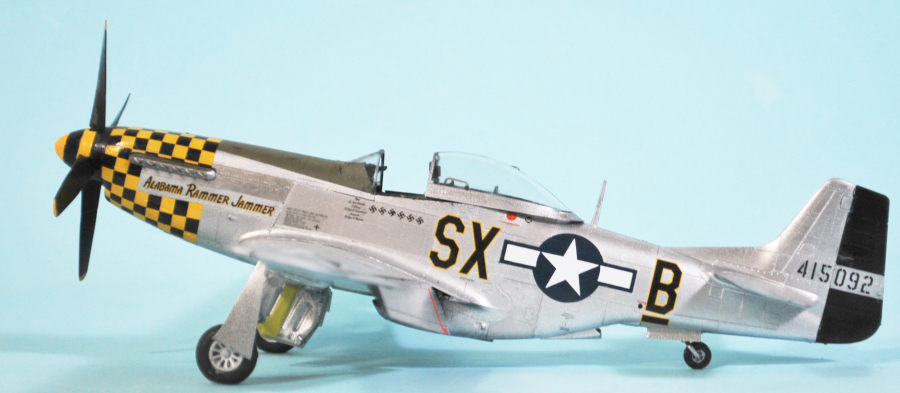
| KIT #: | 82102 |
| PRICE: | $49.99 |
| DECALS: | Six options |
| REVIEWER: | Tom Cleaver |
| NOTES: | Profipack. Barracuda decals |

| HISTORY |
Arthur Cundy and “alabama Rammer Jammer”
Arthur C. Cundy Jr. was born in Birmingham, Alabama on the fourth of July, 1924. His father was veteran of the 1st World War. His mother, Virginia Key, served as a recruiting officer in the WACs. She was a direct descendant of Francis Scott Key, who wrote "The Star-Spangled Banner".
Cundy joined the USAAF in 1943, and graduated from flight school in 1944. He arrived in England in August, assigned to the 352nd Fighter Squadron of the 353rd Fighter Group, based at Raydon in East Anglia and reported to the unit on August 21. The 353rd was the fourth fighter group assigned to the Eighth Air Force, and had become operational in August 1943, just in time to participate in the Regenseburg-Schweinfut mission. At the time Cundy arrived, the group was still flying the P-47 Thunderbolt.
Cundy flew as a wingman. By October 1944, the Jagdwaffe became scarce over Germany due to fuel shortages following the successful oil campaign that summer, which had reduced the output of the German synthetic fuel industry by 65%; coupled with the loss of the Romanian oil fields that summer, the Wehrmacht had 30% of the fuel supply it had a year earlier.
The 353rd re-equipped with the P-51D beginning in October, and was fully operational on the Mustang by mid-November.
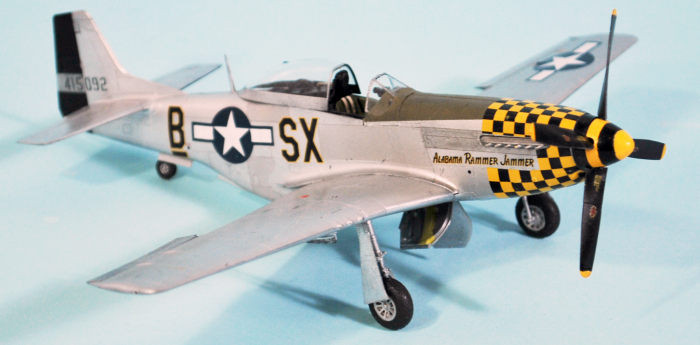 Cundy scored his first victory, a Bf-109, on Novemver 27. He shot down a
Fw-190 the next month. By January 1945, he had moved up to element leader and
been promoted to 1st Lieutenant.
Cundy scored his first victory, a Bf-109, on Novemver 27. He shot down a
Fw-190 the next month. By January 1945, he had moved up to element leader and
been promoted to 1st Lieutenant.
On January 14, 1945, Cundy’s squadron was escorting B-17s of the 91st Heavy Bombardment Group to bomb various highway bridges in Cologne. Due to an instrument failure, the high Bomb Squadron bombed a target of opportunity at Jocketa, a junction of two main rail road lines over a river and ravine. Enemy aircraft were encountered near the target area and in the ensuing air combats, one B-17 and two P-51s were lost. U.S. fighters claimed nine enemy aircraft destroyed and five damaged, with Cundy claiming one Fw-190 destroyed.
On March 2, 1945, Cundy claimed two Fw-190s and one Bf-109 to become an ace with a total of six victories.
On March 11, Cundy was flying P-51D Mustang SX-D 44-14963 “Miss Jackie II,” the personal aircraft of 1st Lieutenant Lindsay W. Grove, when it developed a coolant leak over the North Sea as the group flew outbound toward Germany. Cundy reported he was heading back to England, and was last seen diving through the undercast. His remains have never been recovered.
Arthur Cundy's account of his fight on March 2 reveals a person who would have been interesting to know, had he survived.
"Vicinity of Dessau, SW to Halle. I was leading Jockey Red flight. Someone called in many 109s above us. “In the immediately following confusion and disorder, a lone Me-109 came screaming down past our flight and attacked a Jockey flight low and 10 o'clock to us. Instantly I rolled over and split-essed after him, saw that I could catch the bum, and dropped my tanks.
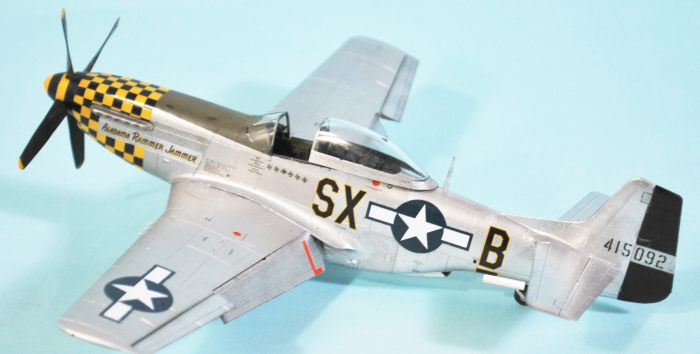 “This particular 109 pilot must have been Adolf Hitler Junior in a
brand-new Superman suit, because not satisfied with his unsuccessful pass at
four of our fighters, he pulled up very steeply and began giving a bomber box
the works from their six o'clock low.
“This particular 109 pilot must have been Adolf Hitler Junior in a
brand-new Superman suit, because not satisfied with his unsuccessful pass at
four of our fighters, he pulled up very steeply and began giving a bomber box
the works from their six o'clock low.
“That's when I tacked on behind and cut loose. I began to get a few scattered and unsatisfactory strikes around his wings and tail, not concentrated because I was at the moment having great difficulty with the great trim displacement from the extreme of vertical dive to stalling vertical climb. For this reason I had not accomplished a darn thing when I was right on him, overtaking, and about to ram into him.
“Just as I booted hard right rudder to avoid collision and passed barely under his right wing, the 109 stalled out and began to tumble and spin. At the very same time I found myself in a similar situation, spinning. “As we spun down side by side out of control, I was extremely gratified to note that a 109 has a more rapid rate of descent in a spin than does a P-51, and the 109 was below me in about one turn. This fact allowed me to see the guy in my gunsight on every turn, so every time my nose swung around for a split second to bear on my adversary, I gave him a short squirt. It was good for my morale. In this manner I got a few more strikes on him before he made a faltering recovery from the spin. I was able to recover easily and did so, coming out of it right behind the 109.
“I followed him down to the clouds, which were rather thin. Having lost the guy temporarily I went straight on through and found him down there again. As soon as he saw me this time, he bailed out without delay, and I got set to strafe him in his chute. Before I squeezed the trigger however, I changed my mind and took his picture instead." Cundy then spotted the first 190.
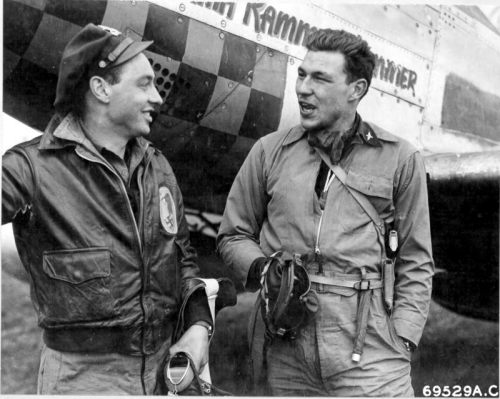 “I came up behind, gave a squirt and the plane caught fire and exploded.
Departing, I spotted another one following me, then lost it when I turned toward
it, but another 190 appeared, heading right at me. That suited me just fine so I
flew on waiting for him to make a nice fit in my gunsight. I gave him just a
short squirt right in the kisser just when he was plenty close. His engine
exploded and he whizzed past me in flames, pulled up steeply and bailed out like
an old hand at the game."
“I came up behind, gave a squirt and the plane caught fire and exploded.
Departing, I spotted another one following me, then lost it when I turned toward
it, but another 190 appeared, heading right at me. That suited me just fine so I
flew on waiting for him to make a nice fit in my gunsight. I gave him just a
short squirt right in the kisser just when he was plenty close. His engine
exploded and he whizzed past me in flames, pulled up steeply and bailed out like
an old hand at the game."
Cundy’s assigned P51D-15-NA 44-15092, SX-B “Alabama Rammer Jammer” was flown after his loss by several pilots, most frequently by Lt. James W. Lamb, who failed to return on April 17, 1945 while flying SX-N. SX-B was then assigned to Lt. William K. Bixby who named it “Lulu Belle II.” Flight Officer Bowron crash it on April 21, 1945 during a local area flight test.
| THE KIT |
P-51Ds have been around for about as long as there have been plastic scale model kits. In 1/48, the first to approach accuracy was the old Hawk (now Testors) P-51D released in the early 60s. This was as good as it got until the 1970s, when Otaki and Revell released kits; the earlier Hawk/Testors kit was actually more accurate in overall shape than either of these releases. The first P-51D kit to be really accurate regarding shape was the still-available Hasegawa 1/72 kit, released in the mid-70s, though nowadays it needs a resin cockpit and a vacuformed canopy to really be competitive with releases in that scale like the recent Airfix kit, considered by many to be the best P-51D in 1/72. Hasegawa took another bite of the apple in 1992 with a P-51D in 1/48 that immediately replaced the previous kits regarding accuracy and detail. Tamiya came along in 1994 with what became the “gold standard” for P-51Ds in 1/48.
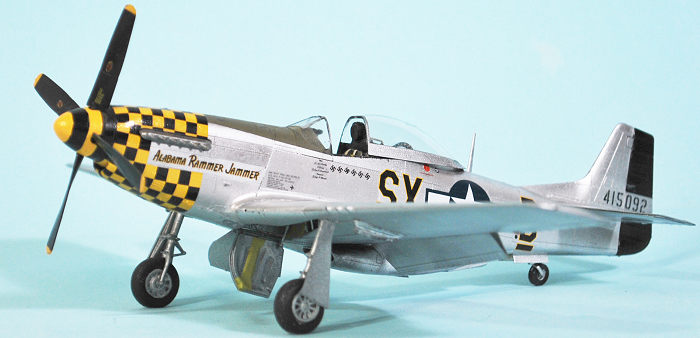 Airfix released a 1/48 P-51D in 2018 that raised the bar considerably
from the Tamiya kit. It was the first in any of the smaller scales to have the
wheel well reproduced accurately, and provided the earlier field-applied dorsal
fin of the P-51D-5 and the later factory fin that showed up with the P-51D-10.
It’s relatively easy to build and makes up into an attractive model.
Airfix released a 1/48 P-51D in 2018 that raised the bar considerably
from the Tamiya kit. It was the first in any of the smaller scales to have the
wheel well reproduced accurately, and provided the earlier field-applied dorsal
fin of the P-51D-5 and the later factory fin that showed up with the P-51D-10.
It’s relatively easy to build and makes up into an attractive model.
Eduard’s P-51D arrived in August 2019, and raised the bar to the top of the posts. The kit is the only one to have the two different dorsal fins - the early one associated with the P-51D-10 and the later one associated with the P-51D-15 and later. Eduard also released a “finless” P-51D-5 and recently released a P-51K after releasing an F-6D photo-recon airplane.
The kits have fully accurate wheel wells, fully-detailed cockpits providing both the early and late pilot’s seat, and different instrument panels associated with the various sub-types. There is no real reason to get an aftermarket cockpit for these kits, though Eduard has released one.
| CONSTRUCTION |
As with all the recent Eduard releases, this kit demands you bring as much modeling excellence to the project as it does. All parts fit very precisely, and any sloppiness in cleaning up all sprue nubs, or hamfistedness in assembly, will lead to multiple problems down the line. Take care in preparation of parts, take care in assembly, commit to the revolutionary act of following the instructions, and the result will be one of the best models you have ever created. If you do it right, you won’t be using any filler anywhere (other than on the wings if you so choose).
Construction begins with the cockpit. I painted all the parts on the
sprue before further assembly, following the kit instructions regarding colors.
There are a myriad of small parts, so take care in separating them from the
sprue lest you feed the carpet monster or they fly off into the Department of
Lost. Fortunately, my new government-supplied eyeballs allowed me to put the
optivisor aside, but if you have one you’re probably going to need it to get
everything done. The result is a very good looking cockpit. I used the
photo-etch instrument panel and most of the other bits (other than those way too
small to make out, and there’s quite a few of them for the more determined
modeler), as well as the very nice seat belts.
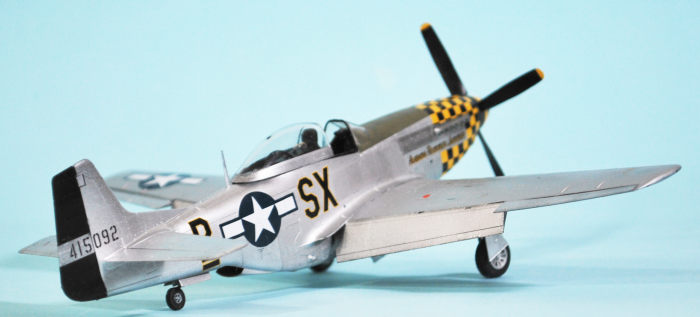 Since I was doing a P-51D-15 that
around in March 1945, I used the K-14 gyro gunsight.
Since I was doing a P-51D-15 that
around in March 1945, I used the K-14 gyro gunsight.
I followed the instructions for attaching all the other fuselage interior parts, and when it came time to bring the fuselage halves together, all was well. I only needed a light scrape down of the centerline to get rid of minor glue build-up.
As I noted, the wheel well includes 13 parts. I painted the main spar yellow zinc-chromate and the rest of the parts with Vallejo White Aluminum to simulate aluminum lacquer, with the YZC plate in the wheel covers. Once it was all assembled, I brushed some Tamiya smoke over everything to simulate oil and dirt and to “pop out” detail.
The wing assembled without difficulty. I particularly liked the separate section for the machine guns, which obviated having to clean up a seam through them. Attaching the wing and fuselage sub-assemblies has been the only area where I have found problems with previous Eudard P-51s. This time, instead of attaching Part G-34 to the top of the gear well assembly, I glued it to the bottom of the cockpit floor, part H-34 and positioned it correctly. Doing this, the wing popped into position with a minimum of effort. I will do this with all future Eduard P-51D kits.
I finished off by attaching the horizontal stabs and the radiator exhaust cover. I used the metal elevators.
| COLORS & MARKINGS |
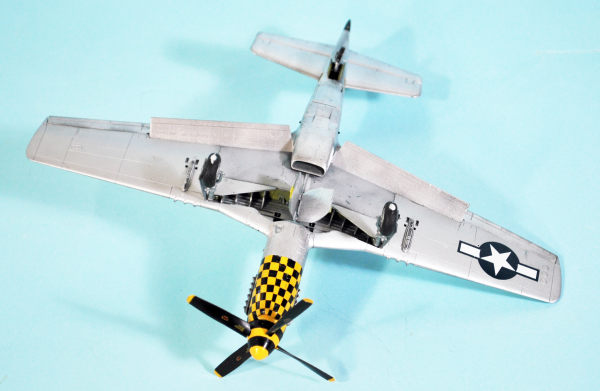 I painted the Olive Drab anti-glare panel, then masked it off. I then
painted the model with an overall coat of Tamiya X-18 “Semi-Gloss Black,”
thinned 60% thinner and misted on to get a mirror finish. I masked off the
rudder, which was painted black.
I painted the Olive Drab anti-glare panel, then masked it off. I then
painted the model with an overall coat of Tamiya X-18 “Semi-Gloss Black,”
thinned 60% thinner and misted on to get a mirror finish. I masked off the
rudder, which was painted black.
When this was dry, I painted the wings with Vallejo “Dull Aluminum” to simulate the puttied wings painted with aluminum lacquer. I then masked that off and painted the rest of the model with Vallejo “Aluminum.” When that was dry, I masked off several other panels and painted them with Vallejo “Semi-matte Aluminum.”
The spinner was painted yellow, then masked and the black stripes were painted.
I used the decals from Barracuda Decals “P-15 Mustang Part 1" for the 353rd FG checkerboard nose and the personal markings for “Alabama Rammer Jammer.” I used the kit decals for the rest of the markings.
I attached the main gear, then I unmasked the canopy and installed it in the open position. I attached the prop and called it done.
| CONCLUSIONS |
It’s another Eduard P-51D Mustang, the best kit of this airplane in 1/48 scale. There will always be room for another one here at Le Chateau du Chat. The kit is so good it’s a lot of fun just seeing if I can top myself with a new one. If you take care in assembly and commit the radical act of following the instructions, it is impossible to get a bad model as a result. Highly recommended for all Mustang lovers.
3 March 2022
Copyright ModelingMadness.com. All rights reserved. No reproduction in part or in whole without express permission.
Review kit courtesy of Eduard.
If you would like your product reviewed fairly and quickly, please contact the editor or see other details in the Note to Contributors.